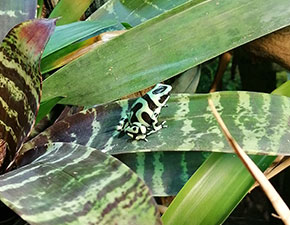
Golden Poison Dart Frog
Phyllobates terribilis
IUCN red list status:
Endangered
For more information, please visit iucnredlist.org

Golden Poison Dart Frogs live in Columbia.

They eay mainly invertebrates.

Eggs are laid on the ground and males transport the larvae to permanent pools.

Golden Poison Dart Frogs can live up to 10 years.
Golden Poison Dart Frog
About the Golden Poison Dart Frog
Poison dart frogs are characterised by their colourful bodies and toxicity. This species is one of the most toxic of all known dart frogs, but also most toxic of most known land vertebrate. These are very small in size - the Golden Poison Dart Frog, being just 5.5 centimetres. Unlike many other amphibians, poison dart frogs are diurnal, meaning they’re most active in the daytime. This is quite rare for frogs, as most species are nocturnal.
Poison dart frogs are known to be among the most poisonous amphibians in the world, but they don’t use this as a means of attack. Instead, it acts as a deterrent, with their brightly-coloured bodies essentially telling would-be predators they're poisonous and shouldn't be eaten - with a range of bright colours including yellows, oranges, reds, greens and blues.
Did you know?
These frogs capture their prey with a long, sticky tongue that darts out and zaps the unsuspecting bug! The frogs eat many kinds of small insects including beetles, which are the ones scientists think may be responsible for the frogs' toxicity.

